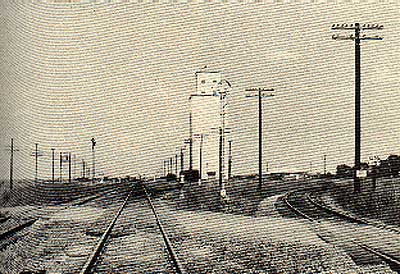|
Moderated by NW Okie! |
Volume 12 , Issue 212010Weekly eZine: (375 subscribers)Subscribe | Unsubscribe Using Desktop... |
Avard, Oklahoma

1975, Avard, the Santa Fe & Frisco tracks interlock a short distance from the elevator. Avard, Woods County, Sections 26 & 35, Township 26N, Range 15W, 7 miles south, 6 miles west of Alva.
According to Ghost Towns of Oklahoma, by John W. Morris, the Post Office began around June 1, 1895 thru November 22, 1963. The newspaper was the Avard Tribune. The Railroad that ran through the town was the Southern Kansas Railway (Santa Fe); Arkansas Valley and Western Railway (Frisco).
1904 - Avard was incorporated when the Frisco tracks were extended westward from Enid to tie in with the transcontinental line of the Santa Fe. The town was well supplied with mercantile establishments, two hotels, bank, livestock exchange, grain elevators and a weekly newspaper.
1909 - The town was the cattle shipping point for a large area with Stock pens adjacent to the tracks. 250 people were reported living in Avard. It was reported that being a railroad town and a cowtown, it was a rough and tough place. The Gay Nineties brought many exciting events that happened in Avard. The saloons kept going all night and the town was side open. It was not uncommon for dead men to be found in the street after a gun battle.
1921 - An Elementary school group and teachers pose in March, 1921 with the elevator in the background, which indicates the importance of the wheat farming. You can also see the house types and other characteristics of western Oklahoma.
1910-1930 - Avard became an important agricultural center and rail transfer point for passengers and freight. Direct passenger trains with the Santa Fe trains made runs from Chicago to Los Angeles. Frisco lines from the east connected with the Santa Fe time schedule. Both trains lines kept agents and full crews stationed in Avard.
Besides the Livestock Market, the town had a large broomcorn warehouse, elevators for wheat storage and shipping, plus a cotton gin. The town also built a community building where plays and concerts were given and public meetings were held. Churches were active and an accredited school was developed. For a brief time there was a dance hall in operation until one brawl and it was closed afterwards.
Mid-1930s - Avard continued to grow like many other Oklahoma agricultural towns it became a victim of the economic depression, dust storms, farm consolidation, and changing methods of travel.
<
1943 1944 - The town was struck by tornadoes, each on a different site. Thereafter a tornado-conscious community got busy and completed a 10x20 foot underground shelter. With donated materials and labor. It was made of solid concrete and was big enough to hold the entire population.
1973 - The Frisco upgraded its line from Tulsa to Avard so that it could interlock with the main line of the Santa Fe at a cost of four million dollars. Five or Six transcontinental freight trains a day highballing through Avard. The change had little effect on the town. A few unused store buildings still remain, but the only services offered are those of a cafe in the old school gymnasium and a grain elevator.
Through the efforts of A. F. Wolf from Fayetteville, Arkansas who anticipated the extension of the Frisco Railroad line westward from Enid, Avard was born.
Avard received it's named from the mother of Frank Todd, whom owned the land Avard was located. Ed S. Roberts established the Bank at beginning of town with his wife as vice-president. Mrs. Roberts was also author of several books: Genealogy of the Oklahoma Daughters of American Revolution, Four Revoluntionary Soldiers & Their Descendants and Some Colonial Families.
| View or Add Comments (0 Comments)
| Receive
updates ( subscribers) |
Unsubscribe
| © . Linda Mcgill Wagner - began © 1999 Contact Me | |
